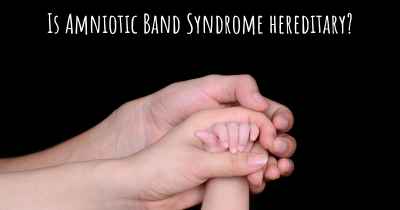What is the history of Amniotic Band Syndrome?
When was Amniotic Band Syndrome discovered? What is the story of this discovery? Was it coincidence or not?

Amniotic Band Syndrome (ABS) is a rare congenital disorder that occurs during fetal development. It is characterized by the presence of fibrous bands that wrap around and constrict various parts of the fetus's body, leading to a wide range of abnormalities and deformities. ABS can affect different parts of the body, including the limbs, fingers, toes, and even the face.
The exact cause of ABS is still unknown, but several theories have been proposed. One prevailing theory suggests that the condition occurs due to the rupture of the amnion, the innermost membrane surrounding the fetus, during early pregnancy. This rupture leads to the formation of fibrous bands that can entangle and disrupt the normal development of the fetus. Another theory suggests that ABS may be caused by genetic factors or environmental influences, although more research is needed to confirm these hypotheses.
The history of Amniotic Band Syndrome dates back to the early 19th century, although it was not officially recognized as a distinct medical condition until much later. In 1832, a French physician named Etienne Serres first described a case of a newborn with constrictive bands around its limbs. However, it wasn't until the 20th century that ABS started to gain more attention from the medical community.
In the early 1900s, several case reports and studies began to shed light on the various manifestations of ABS. Physicians and researchers observed that the fibrous bands could cause a wide range of deformities, including amputations, clubfoot, cleft lip and palate, and limb length discrepancies. These findings helped establish ABS as a distinct clinical entity.
Throughout the 20th century, medical advancements and improved diagnostic techniques allowed for better understanding and identification of ABS. In the 1960s, ultrasound technology emerged as a valuable tool in prenatal diagnosis, enabling the detection of amniotic bands before birth. This development significantly improved the management and treatment of ABS, as it allowed for early intervention and planning.
Over the years, numerous case studies and research papers have contributed to our knowledge of ABS. These studies have explored the various clinical presentations, associated anomalies, and treatment options for affected individuals. Additionally, advancements in surgical techniques, such as microsurgery and limb reconstruction, have provided new possibilities for improving the outcomes of individuals with ABS.
Today, the management of ABS involves a multidisciplinary approach, with specialists from various fields collaborating to provide comprehensive care. Treatment options may include surgical interventions to release constricting bands, amputation of severely affected limbs, orthopedic interventions, and rehabilitation services.
Despite the progress made in understanding and managing ABS, there are still many unanswered questions. Ongoing research aims to uncover the underlying causes of the condition, identify potential genetic factors, and develop more effective treatment strategies. Additionally, support groups and organizations play a crucial role in raising awareness, providing resources, and offering emotional support to individuals and families affected by ABS.
In conclusion, Amniotic Band Syndrome is a rare congenital disorder characterized by fibrous bands that constrict various parts of the fetus's body. Its history can be traced back to the early 19th century, but it wasn't until the 20th century that ABS gained recognition as a distinct medical condition. Advances in diagnostic techniques and surgical interventions have significantly improved the management and treatment of ABS. However, further research is needed to fully understand the causes and develop more effective interventions for this complex condition.
Posted Jul 10, 2023 by MoFast 2550








